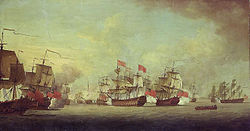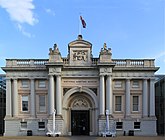English: Knowles's Action off Havana
(Revised April 2013) In February 1748 Rear-Admiral Charles Knowles left Port Royal, Jamaica, with eight ships of the line, to make an attack on Santiago de Cuba. Delayed by contrary winds, he diverted his expedition to Port Louis in the south-east of Hispaniola. Knowles sailed his ships up the channel and passed to the west and north of the fort, which surrendered after a sharp bombardment. The town's surrender followed immediately and Knowles, having taken possession of a snow and three privateers, including the 'Conquistador', 64 guns, burnt the fort and departed for Santiago de Cuba. He was in fact looking for Spanish treasure ships and the Spanish Havana squadron of Admiral Regio put to sea to protect them, encountering Knowles instead soon afterwards.
The 'Cornwall', 80 guns, in port-quarter view, with Knowles's red Rear-Admiral's flag at the mizzen and a red battle flag at the fore, is in the centre of the painting. Her main topmast has been shot away and she is engaging the Spanish flagship, 'Africa', to starboard. All that can be seen of the Spaniard is Admiral Regio's flag above the smoke. Astern and to starboard of the 'Cornwall' is a two-decker also engaging to starboard and, unusually, her stern-galleries are painted red. Astern of her is a large row-barge and beyond, and in the extreme right of the picture, is the sternmost English ship engaging the enemy. In the left half of the picture, forward of the 'Cornwall' is a melée of ships in action, while in the extreme left foreground are two English ships, in port-quarter view. The nearest is thought to be the 'Lennox', 70 guns, although nominally 60 guns, since it unusually has a closed stern. The battle was a messy affair and though a victory for Knowles subsequent recriminations with his captains led to him being reprimanded. Regio - who had to burn the 'Africa' afterwards to prevent her capture - was court-martialled by the Spanish authorities for incompetence.
Little is known about the artist but in November 2008, John F. Millar of Williamsburg, Va., then working on a book on the architect Peter Harrison of Newport, R.I. kindly informed the Museum that he was Captain, later Colonel, Thomas Craskell who served his whole career as a military engineer in Jamaica. In 1758 he was ordered to supervise construction of the handsome King’s House (Governor’s Mansion) at Spanishtown to designs by Harrison (of which only the front wall survives, following a fire in 1925), while in 1795, at the end of his career, he got into trouble through insensitivity to the needs of Maroons (free but impoverished blacks in the mountains) of Trelawney Parish. These facts are repeated as supplied, since not enough is otherwise known of the artist, who did not feature in any of the London public exhibitions that began in the 1760s. The Museum also has one drawing assumed to be by him of the burning of the 'Africa' after the present action (PAF5734) together with an undated engraving of the herring fishery off Shetland (PAI5098) that was made after one of his pictures. It also has a two-sheet engraved map of Jamaica of 1763, signed 'Thomas Craskell, Engineer' and 'John Simpson, Surveyor' (GREN80/4A and 4B). These men were apparently respectively chief engineer and chief surveyor of Jamaica, having done the field work between 1756 and 1761, and published an even more monumental 12-sheet version in 1763 (both issued Daniel Fournier of London). While Colonel Craskell is certainly the man who spent his career on Jamaica to after 1795, whether he was, in fact, also the painter remains to be confirmed.
Knowle's Action off Havana





